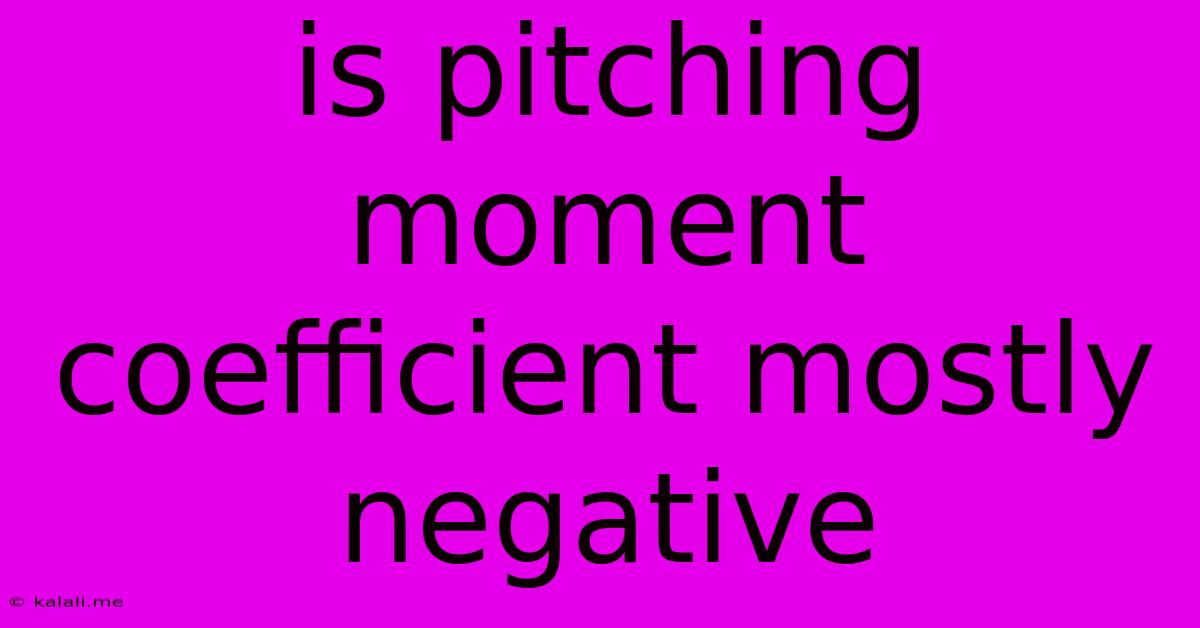Is Pitching Moment Coefficient Mostly Negative
Kalali
Jun 03, 2025 · 3 min read

Table of Contents
Is Pitching Moment Coefficient Mostly Negative? Understanding Aerodynamic Stability
The pitching moment coefficient (Cm) is a crucial aerodynamic parameter that dictates an aircraft's longitudinal stability. It describes the tendency of an aircraft to pitch up or down when disturbed from its equilibrium. A common question among aspiring aerospace engineers and aviation enthusiasts is: Is the pitching moment coefficient mostly negative? The short answer is: generally, yes, but not always. Understanding why requires a deeper dive into the factors influencing Cm.
This article will explore the factors contributing to a negative pitching moment coefficient, discuss exceptions to this rule, and explain the significance of this aerodynamic characteristic for aircraft design and flight stability.
Understanding Pitching Moment and its Coefficient
The pitching moment is the aerodynamic moment acting about the aircraft's center of gravity, causing it to rotate about its lateral axis. A positive pitching moment causes the nose to pitch up, while a negative pitching moment causes the nose to pitch down. The pitching moment coefficient (Cm) normalizes this moment, making it independent of size and airspeed, allowing for easier comparison across different aircraft designs. It's defined as:
Cm = M / (qSč)
where:
- M = pitching moment
- q = dynamic pressure (1/2ρV²)
- S = wing area
- č = mean aerodynamic chord
Why is Cm Often Negative? Static Longitudinal Stability
A negative Cm indicates static longitudinal stability. This means that if the aircraft's angle of attack increases (due to a gust, for example), a negative pitching moment is generated, causing the nose to pitch down. This counteracts the initial disturbance, returning the aircraft to its equilibrium flight condition. This inherent stability is crucial for safe and manageable flight. This negative pitching moment is primarily achieved through:
-
Horizontal Stabilizer: The horizontal tail, or stabilizer, is designed to generate a significant downforce at typical flight angles of attack. This downforce creates a nose-down pitching moment, contributing significantly to the overall negative Cm. The size and placement of the horizontal stabilizer are carefully engineered to achieve the desired stability.
-
Wing Design: The wing's airfoil shape and camber also contribute to the pitching moment. The aerodynamic center of the wing is usually located slightly behind the center of gravity, contributing to a nose-down pitching moment.
-
Center of Gravity Location: The location of the aircraft's center of gravity (CG) relative to the aerodynamic center of the entire aircraft significantly impacts Cm. A rearward CG can reduce stability and lead to a less negative (or even positive) Cm. Conversely, a forward CG enhances stability, making Cm more negative.
Exceptions to the Rule: Positive Cm and Neutral Stability
While a negative Cm is generally desired for stable flight, there are exceptions:
-
High Angle of Attack: At very high angles of attack, the airflow can separate from the wing and horizontal tail, leading to a reduction in downforce and potentially a positive pitching moment. This is a crucial consideration for aircraft maneuverability and stall characteristics.
-
Specific Aircraft Designs: Some specialized aircraft designs, such as highly maneuverable fighter jets, might intentionally operate with a less negative or even slightly positive Cm at certain flight regimes to enhance agility. This usually comes at the cost of increased pilot workload and demanding control inputs.
-
Unstable Aircraft: Some experimental aircraft are intentionally designed with neutral or slightly positive Cm for reasons such as enhanced control responsiveness, although this requires significant pilot skill and advanced flight control systems.
Conclusion
In summary, the pitching moment coefficient (Cm) is usually negative, contributing to the desirable static longitudinal stability of aircraft. This negative Cm is primarily achieved through careful design of the horizontal stabilizer, wing aerodynamics, and precise center of gravity location. However, it’s essential to remember that this isn't a universal rule. High angles of attack, specialized aircraft designs, and experimental configurations can lead to exceptions, emphasizing the complexity and nuanced nature of aerodynamic design. Understanding these factors is fundamental for safe and efficient aircraft operation.
Latest Posts
Latest Posts
-
Chcon Cant Apply Partial Context To Unlabeled File
Jun 05, 2025
-
How Do You Feed Horses On Minecraft
Jun 05, 2025
-
Red Colored Lights Impact On Laser Sensors
Jun 05, 2025
-
Which Specs In A Laptop Drain The Battery Most
Jun 05, 2025
-
Segmentation Is Not Good For Small Objects
Jun 05, 2025
Related Post
Thank you for visiting our website which covers about Is Pitching Moment Coefficient Mostly Negative . We hope the information provided has been useful to you. Feel free to contact us if you have any questions or need further assistance. See you next time and don't miss to bookmark.